Control of Lateral Gas Leakage for Underground Gas Storage in Large-Scale, Low-Permeability Lithologic Reservoirs
Abstract
1. Introduction
2. Background and Methods
2.1. Basic Geological Conditions of Study Area
2.2. Model Construction
2.2.1. Fluid PVT Properties
2.2.2. 3D Simplified Geological Model Construction
2.2.3. 3D Mechanistic Model Construction
2.2.4. Discussion on Model Applicability
3. Results
3.1. Characteristics of Formation Pressure Changes in Transition Zones over Multiple Injection–Withdrawal Cycles
3.1.1. Characteristics of Formation Pressure Changes in Transition Zones over Multiple Injection–Withdrawal Cycles
- Characteristics of Single-Cycle Formation Pressure Variations in Transition Zone
- 2.
- Characteristics of Formation Pressure Variations in Transition Zones under Different Injection–Withdrawal Cycles
- 3.
- Dynamic Evolution Patterns of Multi-Cycle Injection–Withdrawal Pressure in Transition Zone
3.1.2. Spatial Regional Characteristics of Pressure Variations in the Transition Zone
3.1.3. The Causes of Sustained Pressure Increase in the Transition Zone
3.2. Research on the Control Mechanism of Gas Leakage in the Transition Zone
3.2.1. Effect of Formation Permeability on Gas Leakage Control
3.2.2. Effect of Injection–Withdrawal Conditions on Gas Leakage Control
- Gas Injection Schedule
- 2.
- Total injection and withdrawal volume
- 3.
- Location of Boundary Gas Injection Well
- 4.
- Comparative Analysis of Control Parameters
3.3. Application Example
4. Discussion and Conclusions
- (1)
- In the absence of gas leakage control measures, formation pressure in the transition zone steadily increases over multiple injection–withdrawal cycles. Based on the observed pressure evolution patterns, the transition zone can be subdivided into a utilizable region adjacent to the core and a non-utilizable region located farther away. The ongoing rise in boundary formation pressure is primarily driven by the cumulative effects of gas leakage over repeated cycles and the pressure-rebalancing processes within the non-utilizable region.
- (2)
- The effectiveness of gas leakage control in the transition zone of an underground gas storage reservoir is strongly dependent on the permeability pairing between the core and transition zones. When core zone permeability is held constant, formations with a larger permeability contrast exhibit more pronounced suppression of gas leakage. When the permeability contrast is fixed, assemblages with higher core zone permeability demonstrate an increasingly significant control advantage as injection–withdrawal cycles progress. Likewise, with transition zone permeability fixed, assemblages featuring greater permeability contrasts deliver superior control performance.
- (3)
- Adjusting the cyclic injection–withdrawal parameters of underground gas storage can further suppress gas leakage. Reducing the total injection and withdrawal volume yields the most significant control effect in the transition zone, followed by optimizing the injection schedule and, finally, the location of the boundary injection well. To balance operational economy and efficiency, priority should be given to refining the injection schedule; thereafter, the total injection and withdrawal volume should be moderately reduced and the location of the boundary injection well suitably adjusted to achieve efficient, synergistic control of gas leakage in the transition zone.
- (4)
- We define an increase in transition zone boundary formation pressure of no more than 1 MPa as the acceptable threshold for gas leakage. To balance operational economics and efficiency, the injection–withdrawal scheme that maximizes total injection and withdrawal volume is selected as the optimal control scheme. Under the in situ reservoir conditions of the S4 underground gas storage, setting the single-cycle total injection and withdrawal volume to 6000 × 104 m3 requires positioning the boundary injection wells 900 m from the transition zone to achieve effective lateral containment of gas leakage.
Author Contributions
Funding
Data Availability Statement
Acknowledgments
Conflicts of Interest
References
- Xuan, T.; Gao, L.; Qin, P.; Su, Z.; Li, J.; Cai, Z. Feasibility of rebuilding abandoned offshore gas reservoir into underground gas storage: Case study of H gas field in Qiongdongnan Basin. Nat. Gas Geosci. 2022, 33, 324–332. [Google Scholar] [CrossRef]
- Yin, S. Feasibility Study on the Conversion and Construction of Underground Gas Storage from the Wanshunchang Carboniferous Gas Reservoir. Master’s Thesis, Southwest Petroleum University, Chengdu, China, 2015. [Google Scholar]
- Liu, C. Feasibility on Rebuilding the Underground Gas Storage in the Depleted Gas Reservoirs. Pet. Geol. Oilfield Dev. Daqing 2016, 35, 56–59. [Google Scholar] [CrossRef]
- Liao, W.; Liu, G.; Chen, R.; Sun, J.; Zhang, S.; Wang, Y.; Liu, X. Evaluation on the dynamic sealing capacity of underground gas storages rebuilt from gas reservoirs: A case study of Xinjiang H underground gas storage. Nat. Gas Ind. 2021, 41, 133–141. [Google Scholar] [CrossRef]
- Bruno, M.S.; Lao, K.; Diessl, J.; Childers, B.; Xiang, J.; White, N.; Van Der Veer, E. Development of Improved Caprock Integrity Analysis and Risk Assessment Techniques. Energy Procedia 2014, 63, 4708–4744. [Google Scholar] [CrossRef]
- Zhang, P.; Shu, P. Feasibility study on converting vocalnic gas reservoir with edge-bottom water into underground gas storage-A case study from Block D in Xushen Gas Field. Nat. Gas Ind. 2015, 35, 104–109. [Google Scholar]
- Zheng, Y.; Sun, J.; Qiu, X.; Lai, X.; Liu, J.; Guo, Z.; Wei, H.; Min, Z. Connotation and evaluation technique of geological integrity of UGSs in oil-gas fields. Nat. Gas Ind. B 2020, 40, 94–103. [Google Scholar] [CrossRef]
- Watts, N.L. Theoretical Aspects of Cap-Rock and Fault Seals for Single- and Two-Phase Hydrocarbon Columns. Mar. Pet. Geol. 1987, 4, 274–307. [Google Scholar] [CrossRef]
- Wang, C.; Jia, S.; Yang, J.; Zhong, G.; Chen, Z.; Chang, Y. Variation characteristics of dynamic stress of cap rock during gas storage multi-cycle injection-production process. Natrual Gas Oil 2022, 40, 59–68. [Google Scholar] [CrossRef]
- Liu, L.; Sang, Q.; Cao, J.; Zhang, C.; Wang, X.; Ding, Q. Comprehensive evaluation of sealing capacity of depleted gas reservoir reconstructed to gas storage: A case study of Xu 2 gas reservoir in Zhongba Gas Field, northwest Sichuan. Pet. Geol. Oilfield Dev. Daqing 2022, 41, 42–50. [Google Scholar] [CrossRef]
- Zheng, D.; Xu, H.; Wang, J.; Sun, J.; Zhao, K.; LI, C.; Shi, L.; Tang, L. Key evaluation techniques in the process of gas reservoir being converted into underground gas storage. Pet. Explor. Dev. 2017, 44, 794–801. [Google Scholar] [CrossRef]
- Sun, J.; Xu, H.; Wang, J.; Shi, L.; Li, C.; Tang, L.; Zhong, R. Injection–production mechanisms and key evaluation technologies for underground gas storages rebuilt from gas reservoirs. Nat. Gas Ind. 2018, 38, 138–144. [Google Scholar] [CrossRef]
- Mi, L.; Guo, Y.; Li, Y.; Zeng, D.; Lu, C.; Zhang, G. Evaluation of the Dynamic Sealing Performance of Cap Rocks of Underground Gas Storage under Multi-Cycle Alternating Loads. Energy Geosci. 2024, 5, 100319. [Google Scholar] [CrossRef]
- Chen, B.; Li, Q.; Tan, Y.; Yu, T.; Li, X.; Li, X. Experimental Measurements and Characterization Models of Caprock Breakthrough Pressure for CO2 Geological Storage. Earth-Sci. Rev. 2024, 252, 104732. [Google Scholar] [CrossRef]
- Teatini, P.; Castelletto, N.; Gambolati, G. 3D Geomechanical Modeling for CO2 Geological Storage in Faulted Formations. A Case Study in an Offshore Northern Adriatic Reservoir, Italy. Int. J. Greenh. Gas Control 2014, 22, 63–76. [Google Scholar] [CrossRef]
- Ngwenya, B.T.; Elphick, S.C.; Main, I.G.; Shimmield, G.B. Experimental Constraints on the Diagenetic Self-Sealing Capacity of Faults in High Porosity Rocks. Earth Planet. Sci. Lett. 2000, 183, 187–199. [Google Scholar] [CrossRef]
- Pei, Y.; Paton, D.A.; Knipe, R.J.; Wu, K. A Review of Fault Sealing Behaviour and Its Evaluation in Siliciclastic Rocks. Earth-Sci. Rev. 2015, 150, 121–138. [Google Scholar] [CrossRef]
- Ding, G.; Wang, Y.; Wanyan, Q.; Wang, J.; Xu, H.; Li, K.; Xia, Y.; Li, L.; Zeng, D.; Liu, Z. Construction difficulties and research directions of various complex UGSs. Nat. Gas Ind. 2023, 43, 14–23. [Google Scholar] [CrossRef]
- Li, J.; Xia, Y.; Zhang, J.; Wang, D.; Zhao, C.; Wang, W. Key Technologies and Development Directions for the Design and Operation of Low-Permeability Lithologic Gas Reservoir-Type Gas Storage. In Proceedings of the 33rd National Natural Gas Academic Annual Conference (2023) (06 Comprehensive Topics), Nanning, China, 31 May–2 June 2023; Natural Gas Professional Committee of the Chinese Petroleum Society: Beijing, China, 2023; p. 11. [Google Scholar]
- Chen, F.; Yan, Z.; Wu, Y.; Xia, Y.; You, L. Techniques for UGS Sealing Evaluation of Lithologic Gas Reservoir—A Case Study of SH224 UGS in Jingbian Gas Field. Unconv. Oil Gas 2015, 2, 58–64. [Google Scholar]
- Feng, M.; Li, F.; Bai, H.; Hou, K.; Tian, Q.; Liu, Z. Comprehensive Evaluation Method for Sealing Performance of Lithologic Gas Reservoir-Type Gas Storage—Taking the SD5 Gas Storage in Sulige Gas Field as an Example. In Proceedings of the National Natural Gas Academic Annual Conference, Hangzhou, China, 19–20 September 2017; Natural Gas Professional Committee of the Chinese Petroleum Society: Beijing, China; Sichuan Petroleum Society: Chengdu, China; Zhejiang Petroleum Society: Zhoushan, China, 2017; p. 8. [Google Scholar]
- Wang, J.; Wang, J.; Xu, S.; Wu, R.; Lv, J.; Li, Z.; Li, C.; Zhang, J.; Zhao, L.; Xie, J.; et al. A Novel Mode for “Three Zones” Collaborative Reconstruction of Underground Gas Storage and Its Application to Large, Low-Permeability Lithologic Gas Reservoirs. Energy 2022, 253, 124148. [Google Scholar] [CrossRef]
- Yang, Q.; Tian, W.; Wang, Y.; Sun, J. Site selection and effect analysis of lithologic gas storage. Petrochem. Ind. Appl. 2022, 41, 90–93. [Google Scholar] [CrossRef]
- Li, C.; Wang, J.; Xia, Y.; Sun, J.; Zhong, R.; Tu, K. A New Model for Large Lithological Underground Gas Storage Rebuilded and Dynamic Boundary Prediction Method. In Proceedings of the 2023 International Field Exploration and Development Conference 2023, Wuhan, China, 20–22 September 2023; IFEDC Organizing Committee: Beijing, China, 2023. [Google Scholar]
- Zhang, J.; Xia, Y.; Zhao, C.; Wang, L. Key technologies for geological evaluation of UGSs rebuilt from low-permeability lithological gas reservoirs in the Ordos Basin. Nat. Gas Ind. 2023, 43, 55–63. [Google Scholar] [CrossRef]
- Li, C.; Min, Z.; He, H.; Liu, J.; Tu, K.; Wu, H. New Trend and Development Suggestions for Change of Underground Gas Storage Sites in China. Pet. Drill. Tech. 2024, 52, 153–158. [Google Scholar]
- Li, J.; Xia, Y.; Wang, D.; Zhao, C.; Zhang, J.; Wang, L.; He, Y.; An, W. Key technologies of construction design and operation optimization for underground gas storage of low permeability lithologic gas reservoirs in Ordos Basin. Nat. Gas Geosci. 2023, 34, 1442–1451. [Google Scholar] [CrossRef]
- Xia, Y.; Zhang, J.; He, Y.; Yang, Q.; Wang, L.; Fu, J.; Wang, W. Feasibility and operating index design of low permeability lithological reservoir into underground gas storage: Case study of S area in Ordos Basin. Nat. Gas Geosci. 2023, 34, 1452–1459. [Google Scholar] [CrossRef]
- Li, Q.; Han, Y.; Liu, X.; Ansari, U.; Cheng, Y.; Yan, C. Hydrate as a By-Product in CO2 Leakage during the Long-Term Sub-Seabed Sequestration and Its Role in Preventing Further Leakage. Environ. Sci. Pollut. Res. 2022, 29, 77737–77754. [Google Scholar] [CrossRef]
- Li, Q. Reservoir Science: A Multi-Coupling Communication Platform to Promote Energy Transformation, Climate Change and Environmental Protection. Reserv. Sci. 2025, 1, 1–2. [Google Scholar] [CrossRef]
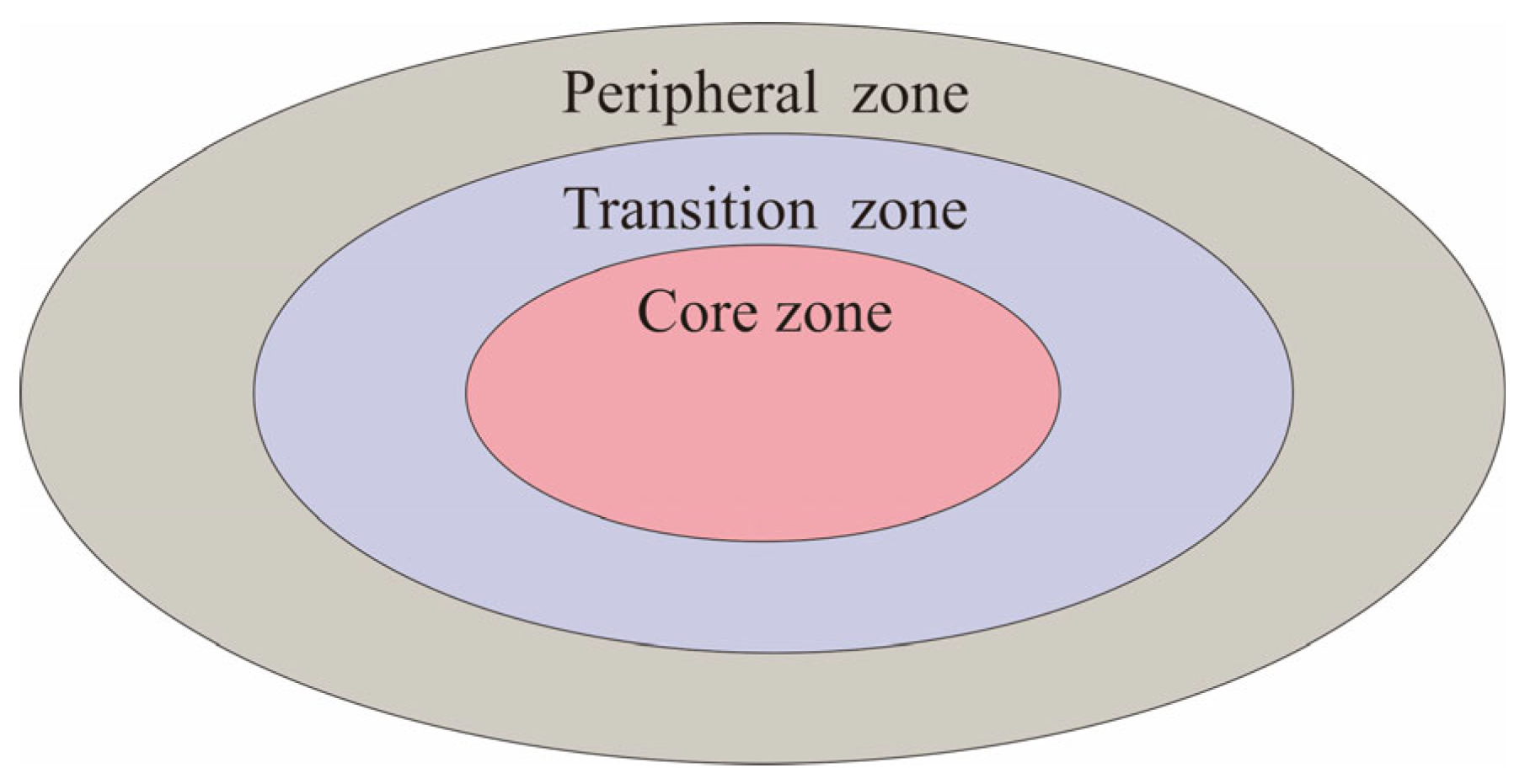



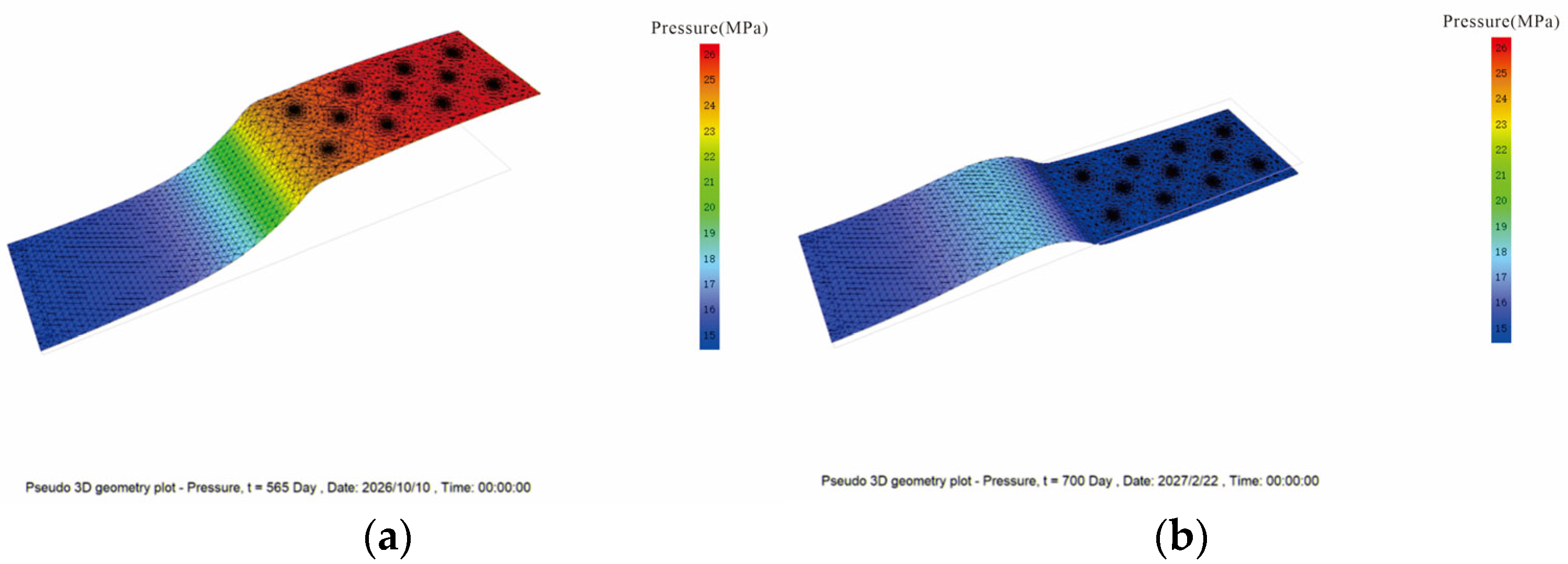



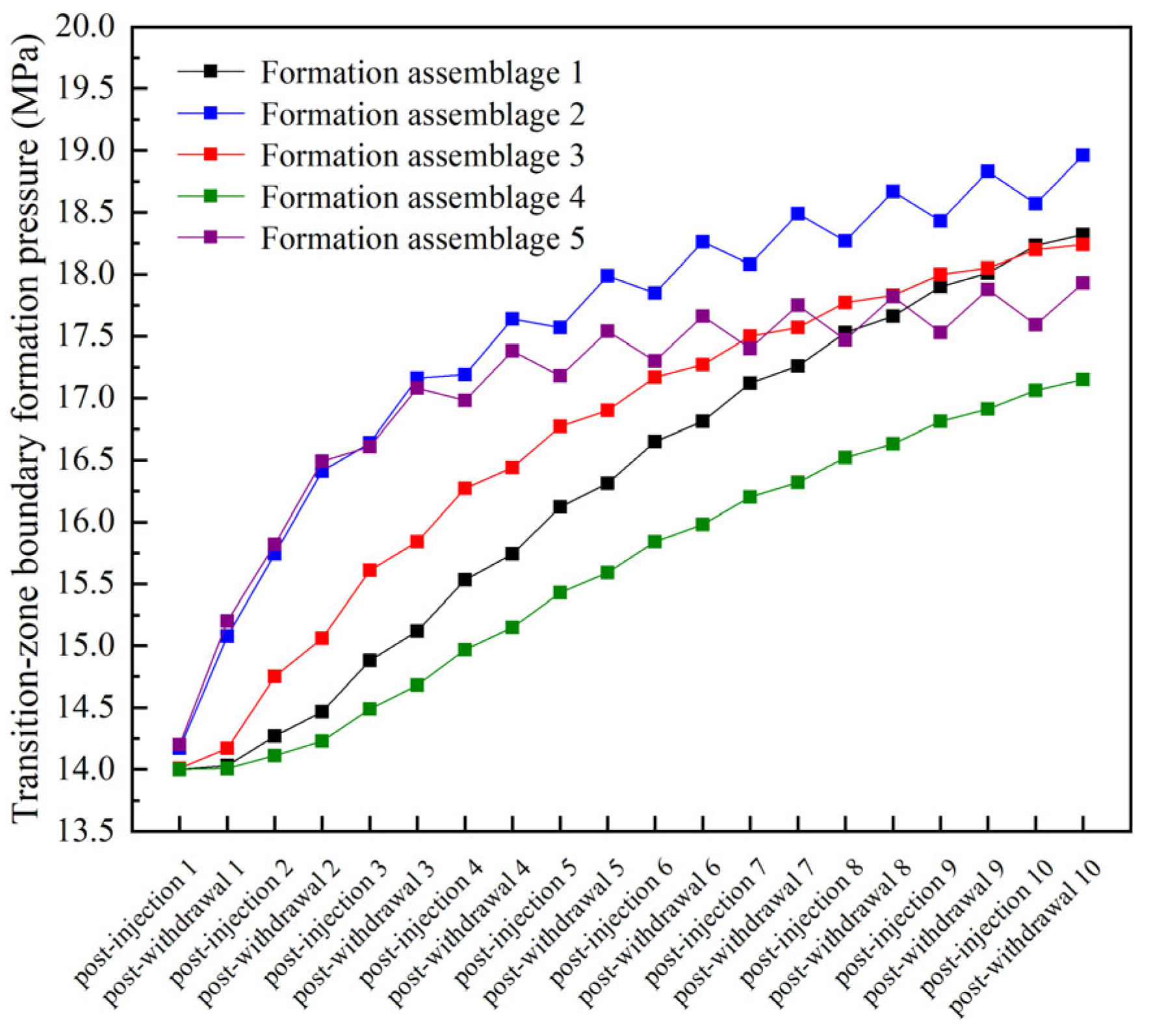

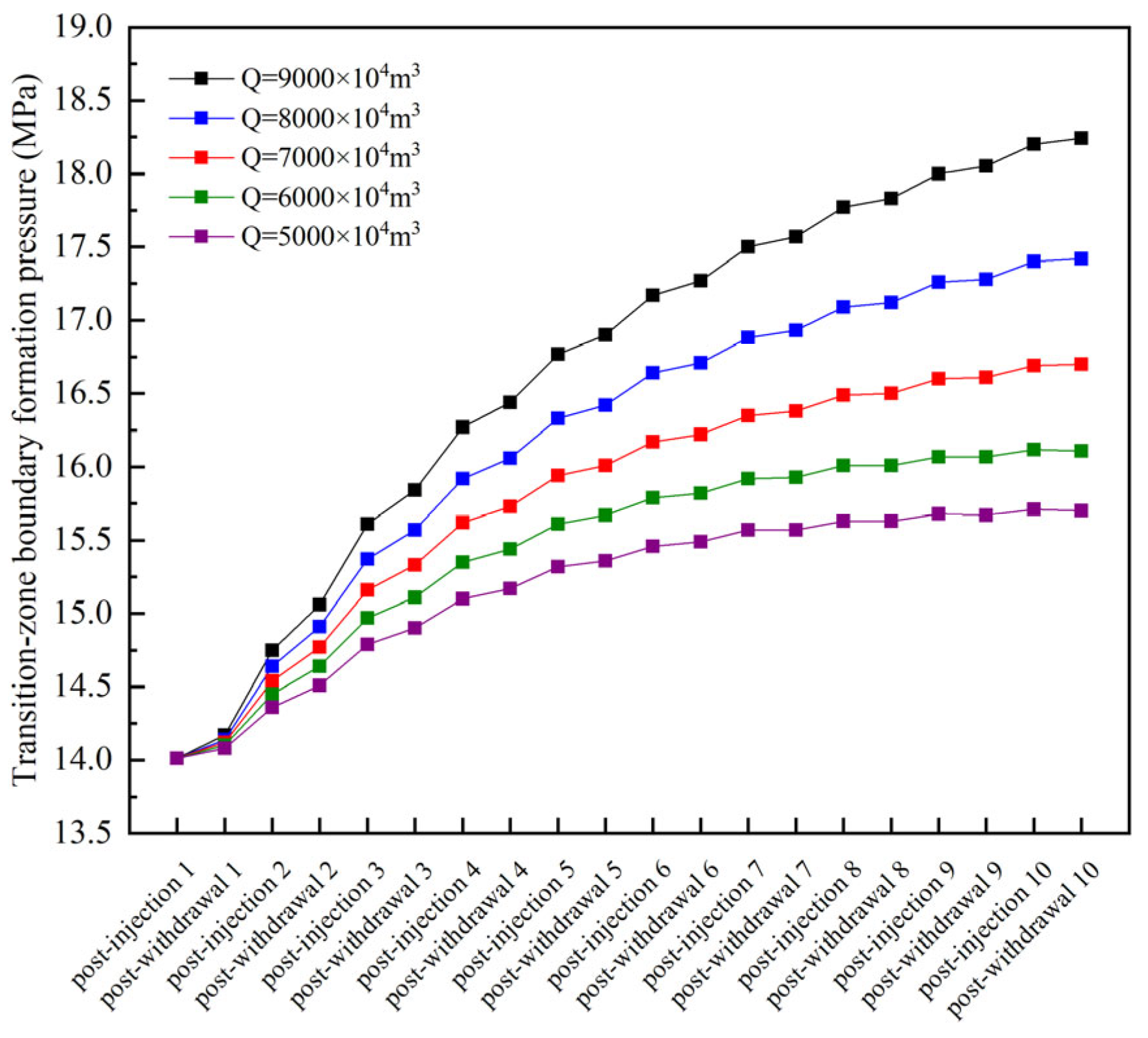
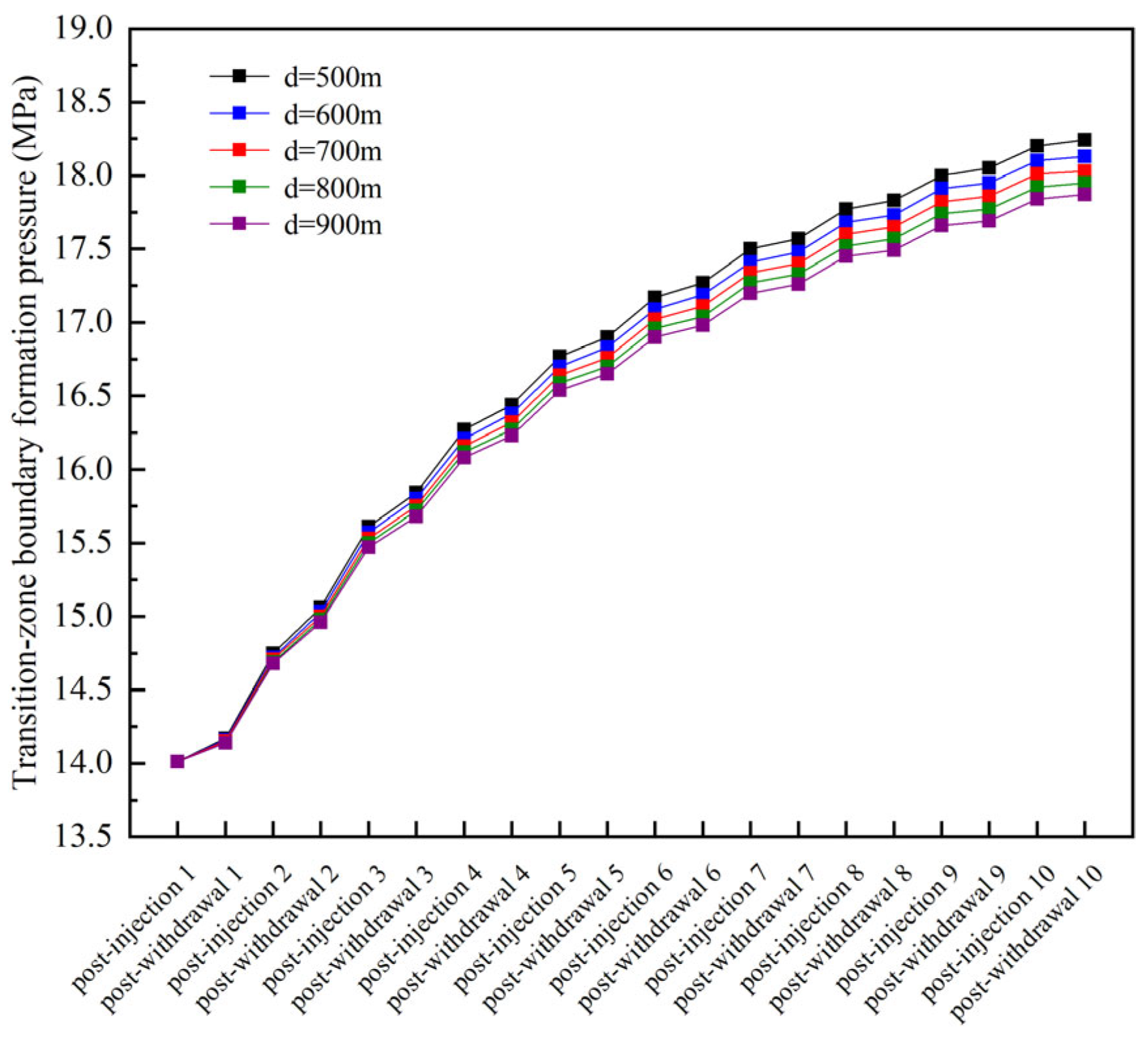
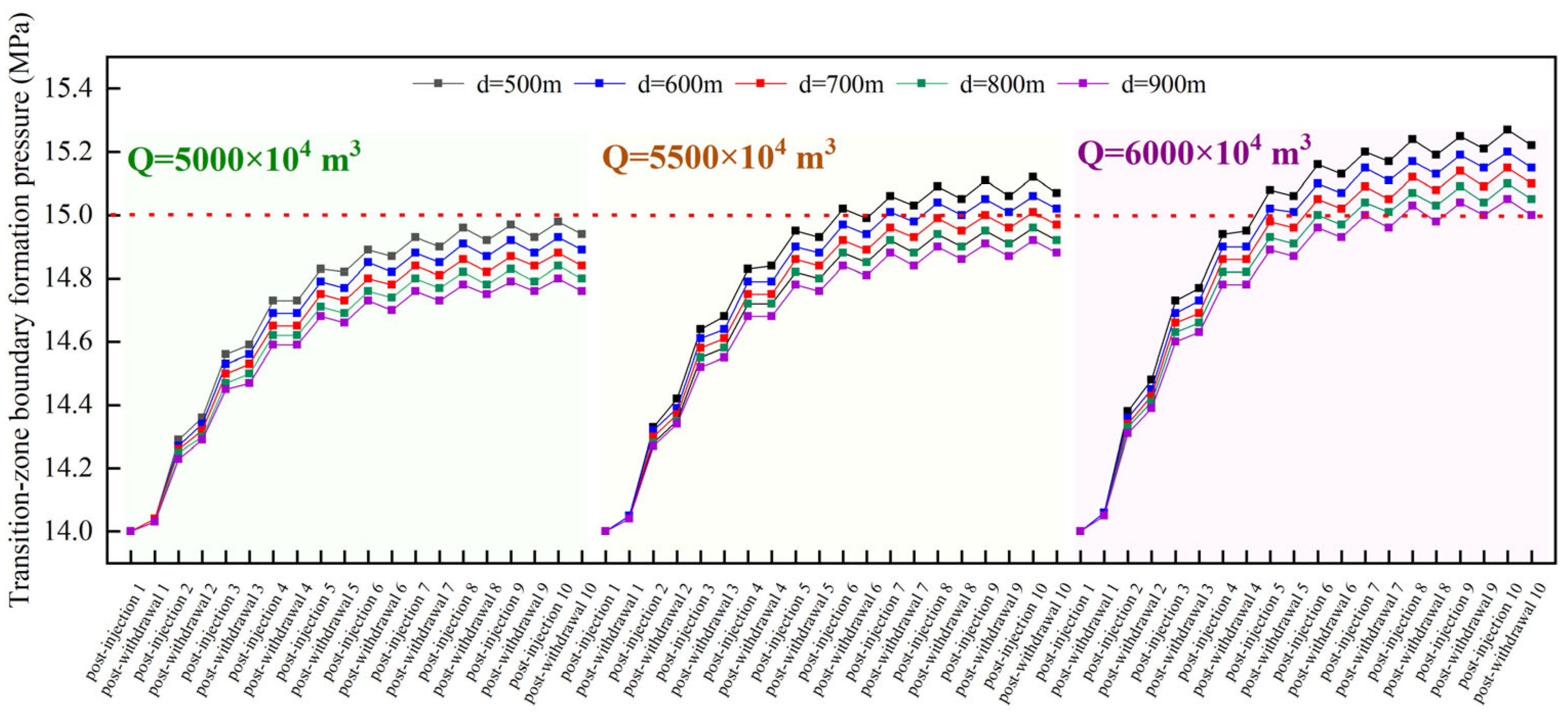
| Rock Type | Representative UGS | Gas-Bearing Area | Reservoir Lithology | Sedimentary Facies | Lateral Sealing Controlling Boundary |
|---|---|---|---|---|---|
| Clastic Rock | Y3 | 125.8 km2 | Sandstone | Delta Facies | Interchannel Argillaceous Flow Barrier |
| Carbonate Rock | S2, SD | 19.3 km2, 21.2 km2 | Dolomite | Tidal Flat Facies | Erosional Trough, Lithologic Pinch-Out |
| Average Value | Core Zone | Transition Zone |
|---|---|---|
| Effective Thickness (m) | 3.94 | 2.44 |
| Porosity (%) | 6.25 | 4.80 |
| Well Testing Permeability (mD) | 10.88 | 2.17 |
| Dynamic Reserves (108 m3) | 6.41 | 1.91 |
| Cumulative Gas Production (108 m3) | 4.61 | 1.02 |
| Absolute Open Flow (AOF) (104 m3/d) | 76.17 | 19.37 |
| Calculation Parameters | Values |
|---|---|
| Pre-Injection Formation Pressure (MPa) | 14 |
| Porosity (%) | 10 |
| Formation Thickness (m) | 4 |
| Permeability of Core Zone k1 (mD) | 15 |
| Permeability Contrast (k1/k2) | 10 |
| Gas Injection Duration per Cycle t (days) | 200 |
| Distance from Boundary Gas Injection Well to Transition Zone d (m) | 500 |
| Total Gas Injection–Withdrawal Volume per Cycle Q (104 m3) | 9000 |
| Calculation Parameters (Units) | Values |
|---|---|
| Pre-Injection Formation Pressure (MPa) | 14 |
| Porosity Φ (%) | 10 |
| Formation Thickness (m) | 4 |
| Permeability k1 of Core Zone (mD) | 10~30 |
| Permeability Contrast (k1/k2) | 5~20 |
| Gas Injection Duration per Cycle t (days) | 50~200 |
| Distance from Boundary Gas Injection Well to Transition Zone d (m) | 500~900 |
| Total Gas Injection–Withdrawal Volume per Cycle Q (104 m3) | 5000~9000 |
| Core Zone Permeability (mD) | Transition Zone Permeability (mD) | Permeability Contrast | |
|---|---|---|---|
| Formation Assemblage 1 | 10 | 1 | 10 |
| Formation Assemblage 2 | 15 | 3 | 5 |
| Formation Assemblage 3 | 15 | 1.5 | 10 |
| Formation Assemblage 4 | 15 | 0.75 | 20 |
| Formation Assemblage 5 | 30 | 3 | 10 |
| Injection Duration (Injection Period: 200 Days) | |
|---|---|
| Scheme 1 | 50-Day Injection Followed by 150-Day Shut-In |
| Scheme 2 | 100-Day Injection Followed by 100-Day Shut-In |
| Scheme 3 | 150-Day Injection Followed by 50-Day Shut-In |
| Scheme 4 | 200-Day Injection |
| Scheme 5 | 50-Day Shut-In Followed by 150-Day Injection |
| Scheme 6 | 100-Day Shut-In Followed by 100-Day Injection |
| Scheme 7 | 150-Day Shut-In Followed by 50-Day Injection |
| Core Zone Permeability (mD) | Transition Zone Permeability (mD) | Permeability Contrast | |
|---|---|---|---|
| 1 | 10.34 | 0.99 | 10.44 |
| 2 | 16.54 | 1.96 | 8.44 |
| 3 | 10.55 | 2.05 | 5.15 |
| 4 | 14.61 | 3.26 | 4.48 |
Disclaimer/Publisher’s Note: The statements, opinions and data contained in all publications are solely those of the individual author(s) and contributor(s) and not of MDPI and/or the editor(s). MDPI and/or the editor(s) disclaim responsibility for any injury to people or property resulting from any ideas, methods, instructions or products referred to in the content. |
© 2025 by the authors. Licensee MDPI, Basel, Switzerland. This article is an open access article distributed under the terms and conditions of the Creative Commons Attribution (CC BY) license (https://creativecommons.org/licenses/by/4.0/).
Share and Cite
Ou, L.; Ding, G.; Xu, S.; Su, Y.; Xu, H.; Lai, X.; Wu, Y.; Zhang, B.; Zhao, W. Control of Lateral Gas Leakage for Underground Gas Storage in Large-Scale, Low-Permeability Lithologic Reservoirs. Processes 2025, 13, 3201. https://doi.org/10.3390/pr13103201
Ou L, Ding G, Xu S, Su Y, Xu H, Lai X, Wu Y, Zhang B, Zhao W. Control of Lateral Gas Leakage for Underground Gas Storage in Large-Scale, Low-Permeability Lithologic Reservoirs. Processes. 2025; 13(10):3201. https://doi.org/10.3390/pr13103201
Chicago/Turabian StyleOu, Lanhantian, Guosheng Ding, Shujuan Xu, Yunhe Su, Hongcheng Xu, Xin Lai, Yanqi Wu, Bingtong Zhang, and Wenjing Zhao. 2025. "Control of Lateral Gas Leakage for Underground Gas Storage in Large-Scale, Low-Permeability Lithologic Reservoirs" Processes 13, no. 10: 3201. https://doi.org/10.3390/pr13103201
APA StyleOu, L., Ding, G., Xu, S., Su, Y., Xu, H., Lai, X., Wu, Y., Zhang, B., & Zhao, W. (2025). Control of Lateral Gas Leakage for Underground Gas Storage in Large-Scale, Low-Permeability Lithologic Reservoirs. Processes, 13(10), 3201. https://doi.org/10.3390/pr13103201





